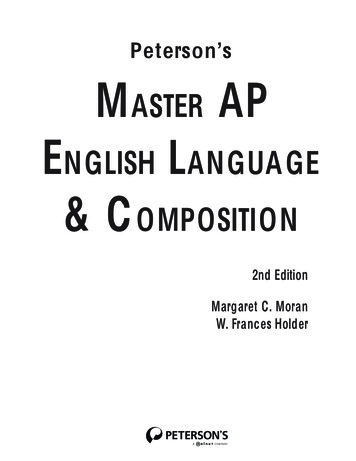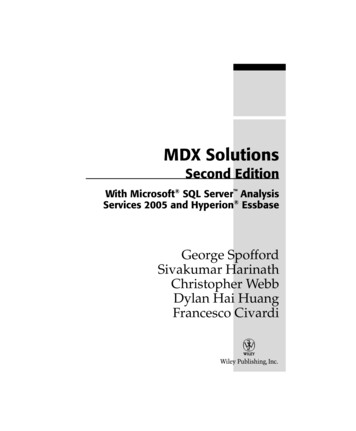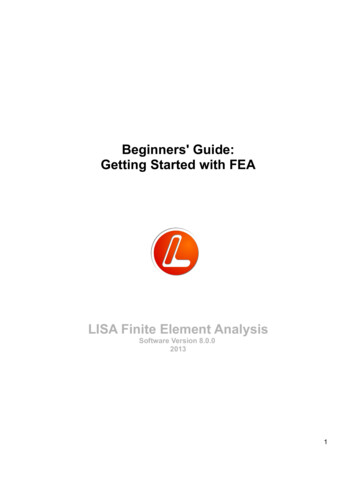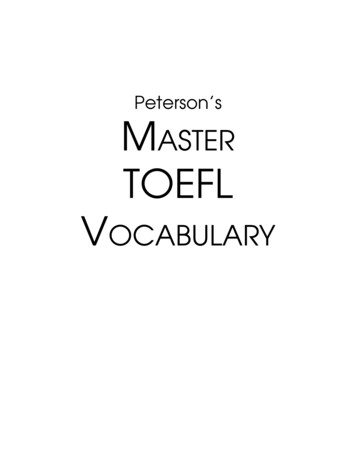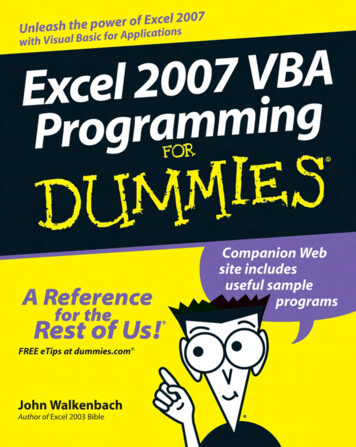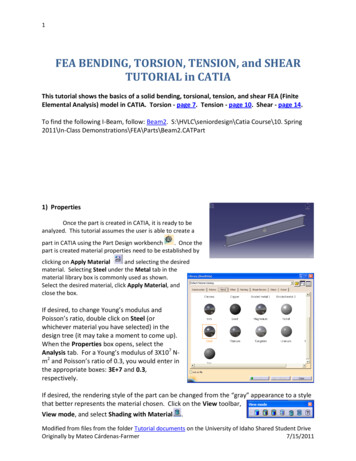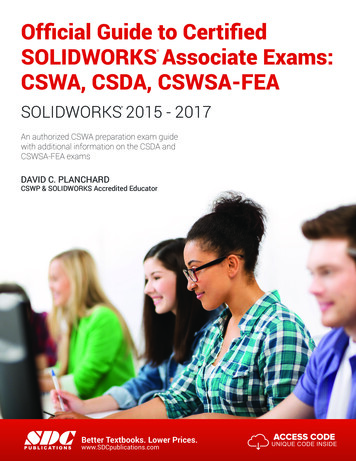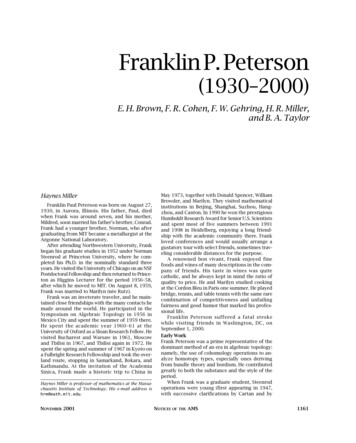
Transcription
fea-peterson.qxp10/15/0110:04 AMPage 1161Franklin P. Peterson(1930–2000)E. H. Brown, F. R. Cohen, F. W. Gehring, H. R. Miller,and B. A. TaylorHaynes MillerFranklin Paul Peterson was born on August 27,1930, in Aurora, Illinois. His father, Paul, diedwhen Frank was around seven, and his mother,Mildred, soon married his father’s brother, Conrad.Frank had a younger brother, Norman, who aftergraduating from MIT became a metallurgist at theArgonne National Laboratory.After attending Northwestern University, Frankbegan his graduate studies in 1952 under NormanSteenrod at Princeton University, where he completed his Ph.D. in the nominally standard threeyears. He visited the University of Chicago on an NSFPostdoctoral Fellowship and then returned to Princeton as Higgins Lecturer for the period 1956–58,after which he moved to MIT. On August 8, 1959,Frank was married to Marilyn (née Rutz).Frank was an inveterate traveler, and he maintained close friendships with the many contacts hemade around the world. He participated in theSymposium on Algebraic Topology in 1956 inMexico City and spent the summer of 1959 there.He spent the academic year 1960–61 at theUniversity of Oxford as a Sloan Research Fellow. Hevisited Bucharest and Warsaw in 1961, Moscowand Tbilisi in 1967, and Tbilisi again in 1972. Hespent the spring and summer of 1967 in Kyoto ona Fulbright Research Fellowship and took the overland route, stopping in Samarkand, Bokara, andKathmandu. At the invitation of the AcademiaSinica, Frank made a historic trip to China inHaynes Miller is professor of mathematics at the Massachusetts Institute of Technology. His e-mail address ishrm@math.mit.edu.NOVEMBER 2001May 1973, together with Donald Spencer, WilliamBrowder, and Marilyn. They visited mathematicalinstitutions in Beijing, Shanghai, Suzhou, Hangzhou, and Canton. In 1990 he won the prestigiousHumboldt Research Award for Senior U.S. Scientistsand spent most of five summers between 1991and 1998 in Heidelberg, enjoying a long friendship with the academic community there. Frankloved conferences and would usually arrange agustatory tour with select friends, sometimes traveling considerable distances for the purpose.A renowned bon vivant, Frank enjoyed finefoods and wines of many descriptions in the company of friends. His taste in wines was quitecatholic, and he always kept in mind the ratio ofquality to price. He and Marilyn studied cookingat the Cordon Bleu in Paris one summer. He playedbridge, tennis, and table tennis with the same rarecombination of competitiveness and unfailingfairness and good humor that marked his professional life.Franklin Peterson suffered a fatal strokewhile visiting friends in Washington, DC, onSeptember 1, 2000.Early WorkFrank Peterson was a prime representative of thedominant method of an era in algebraic topology:namely, the use of cohomology operations to analyze homotopy types, especially ones derivingfrom bundle theory and bordism. He contributedgreatly to both the substance and the style of theperiod.When Frank was a graduate student, Steenrodoperations were young (first appearing in 1947,with successive clarifications by Cartan and byNOTICESOF THEAMS1161
fea-peterson.qxp10/15/0110:04 AMPage 1162Ph.D. Students of Frank PetersonPeter Anderson (1964)Vincent Giambalvo (1966)Gregory Brumfiel (1967)David Segal (1967)Carey Mann (1969)Stephen Williams (1969)Hans Salomonsen (1971)E. Bruce Williams (1972)W. Stephen Wilson (1972)Henry Walker (1973)Arthur Goldhammer (1973)Manuel Moriera (1975)James Krevitt (1977)Kenneth Prevot (1977)David Anick (1980)Michael Hoffman (1981)Paul Goerss (1983)Ethan Devinatz (1985)Raymond Coley (1985)Thomas Hunter (1987)Kathryn Lesh (1988)Hal Sadofsky (1990)Steenrod and his student José Adem continuinginto the early 1950s). Serre’s thesis (1951) extended the scope of methods involving fibrations,and it together with Borel’s thesis (published in1953) and the discovery by William Massey (anearlier student of Steenrod) of exact couples (1952)finally made Leray’s theory of spectral sequencesaccessible. In an early paper Serre also introducedthe first theory of localization in topology in theform of his “mod C ” calculations.Frank’s thesis exploited these new tools to extend known results about homotopy classes ofmaps from a complex K into the n-sphere S n . Hopfhad shown that if dim K n , then cohomologyclassifies such classes. The description of [K, S n ]in case dim K n 1 was the problem that ledSteenrod to discover the squares in the first place,and Frank now went further to prove classificationresults localized at a prime, using the mod C theory. Following a suggestion of John Moore, he alsointroduced coefficients into the picture by mappinginto a “Moore space” M(G, n) (a simply connectedspace whose only nonzero reduced homologygroup is Hn (M(G, n)) G ) in place of a sphere.(Much later Moore and his collaborators were to usethe notation P n 1 (pr ) in case G is a cyclic groupof order pr to denote spaces of this type.) Frankused to talk about Steenrod’s demanding standards, claiming that he wrote from scratch sevendrafts of his thesis before Steenrod wassatisfied.Very early on (1949) Steenrod had defined functional primary operations. Adem (1952) had made1162NOTICESOF THEAMSa start at defining secondary operations, and Masseyhad reported on his triple products in Mexico Cityin 1956, but these things were still very mysterious. Among the objectives Frank set himself wasthe task of establishing the general propertiesof higher-order operations. Postnikov’s work onk -invariants appeared in Russian in 1955 and gavea context for studying higher-order operations (aswell as clarifying the contents of Frank’s thesis), andFrank became an expert, perhaps the leading expert, at operating this machinery. Some of his jointwork with Norman Stein set out the basic definitions and proved the fundamental “Peterson-Steinformulas”. See [6] for a modern perspective onthese operations and an indication of their importance today.Frank was not by nature a machine builder,however. He loved to compute and looked to geometric questions to guide him in his choice ofcomputational project. Characteristic classes ofvector bundles provided him with one such area.He applied the same machinery he had employedin his thesis to give simple conditions under whichthe triviality of characteristic classes impliestriviality of the vector bundle. In the oppositedirection, as a complement to the construction byMassey of secondary characteristic classes of abundle with trivial Euler class, Peterson and Steincomputed the cohomology of the universalexample and showed that Massey’s classes arealgebraically independent.These calculations led to collaboration with BillMassey on a study of the cohomology of fiberspaces. The key idea was to study a fiber bundlep : E B by means of a pair (ET , E) , where ET isthe fiberwise cone of E . This idea becomes effective only under rather strong geometric andalgebraic hypotheses on the fibration, but onesthat are satisfied in many important situations. Inmodern terms their method amounts to considering the low homological dimension portion of theEilenberg-Moore spectral sequence, and thehypotheses are designed to guarantee that thisportion generates the E 2 -term and that the spectral sequence collapses. Their work grew into anAMS Memoir [7].The Adams spectral sequence (1956) was anotherfoundation stone of the edifice of algebraic topology in the second half of the twentiethcentury. It provided a mechanical way of studyingthe implications of higher-order operations andoffered an alternative to the Postnikov tower,using homological algebra over the mod p Steenrodalgebra Ap to begin a direct computation ofhomotopy classes of maps. Adams restricted himself to the stable range, but in their Memoir Masseyand Peterson constructed, under appropriateconditions on a space X, an “unstable Adams tower”for X . Massey has written: “My memory is thatmost of these papers were genuine jointVOLUME 48, NUMBER 10
fea-peterson.qxp10/15/0110:04 AMPage 1163collaborations. Two exceptions: the unstable Adamsspectral sequence was almost entirely Frank’swork, while the Noetherian property of unstablemodules over the mod 2 Steenrod algebra was mycontribution.”Although the simplicial methods of Bousfieldand Kan have since provided a much more generalconstruction, the Massey-Peterson tower hasproved easy to use and of surprising power andversatility. John Harper, Richard Kane, and othershave used it to analyze H-spaces, and they arefundamental to Mark Mahowald’s perspective onunstable homotopy theory. The category U ofunstable modules over the Steenrod algebra, asexplored by Massey and Peterson, turns out to relate intimately to modern objects such as Mac Lanehomology and topological Hochschild homology.The final building block of the edifice of algebraic topology of this era was René Thom’s workon cobordism (1954). This opened the way to manygeometric applications of homotopy theory, inwhich Frank was an active participant. He wasdelighted by Arunas Liulevicius’s application of theHopf algebra methods of Milnor and Moore. Frank’sgreat contributions to our understanding of cobordism frequently occurred in joint work with EdBrown, who has more to say about this below. Thiswas truly one of the great collaborations in thehistory of topology.Frank’s perspective on basic homotopy theoryis captured by the book Cohomology Operationsand Applications in Homotopy Theory, by RobertMosher (whom Frank regarded as his first student,though George Whitehead signed the thesis) andMartin Tangora. Mosher’s lectures, upon whichthis book is based, closely followed lectures byFrank at MIT.In later years Frank’s interest focused increasingly on the algebraic structure imposed by anaction of the mod 2 Steenrod algebra. An earlymanifestation of this interest was his work in theearly 1970s with John Moore. They establishedeasily checked conditions on a bounded-belowmodule M over Ap , at an odd prime p, guaranteeing that M is free, in analogy with a theoremof Adams and Margolis at the prime 2 . They alsogave general algebraic conditions on a gradedalgebra guaranteeing that among bounded-belowmodules the properties of being flat, projective, andinjective coincide.Frank was always quick to appreciate the potential of new ideas in the subject. A good example of this is his work with Vince Giambalvo thatuses a new basis for the Steenrod algebra recentlydiscovered by Dan Arnon to express the ideal ofoperations annihilating all elements of H (RP ) .ServiceFrank identified deeply with “Tech”, as he calledMIT. He served as chairman of the omnibus PureMathematics Committee for the years 1972–75,NOVEMBER 2001Franklin P. Peterson1979–82, and 1984–87. In addition, he served asthe graduate admissions chairman a number oftimes and expressed great pride at how well thestudents he had chosen turned out.Frank signed the theses of twenty-two Ph.D. students at MIT (see the sidebar). Several of these theses became fundamental to later developments intopology. Frank was a supportive and open-mindedadvisor. He was the de facto advisor also of RobertMosher (formally George Whitehead’s student) andof Peter Landweber (formally Raoul Bott’s).Frank taught his share of service courses. Hewould dress for the occasion of a large lecture bydonning his legendary bow tie. At some point inthe early 1980s Frank decided that his students byand large just did not seem as prepared as theyhad a decade or so earlier. Rather than leave it atthat, with a complaint, Frank agreed the next yearto read admission folders. He ranked the group hewas assigned, kept a record of his rankings, andthen compared his ranking with the choices madeby the MIT admissions department. He was outraged to find that the MIT choices were close tothe reverse of his own. He let his dissatisfactionbe known, and a faculty movement was born,one which ultimately refocused the admissionscriteria used by MIT.One of the first things Frank did on arriving atMIT was to found (in collaboration with Ed Brown)the Monday MIT Topology Seminar, in imitation ofLefschetz’s Thursday Topology Seminar atPrinceton. This became the central meeting pointfor topologists of all persuasions in the CambridgeNOTICESOF THEAMS1163
fea-peterson.qxp10/15/0110:04 AMPage 1164area. In the early 1960she would make takingnotes at the seminarand mimeographingthem for distribution apart of the paidResearch Assistantshipduties of a graduate student in topology. Animportant part of theprocess for Frank wasthe choice of restaurantfor dinner after thePeterson with Cathleen Morawetz at his seminar. He liked to disAMS retirement party in February 1999. cover restaurants thatdid not yet have a liquorlicense and arrangewith them to bring his own wine, whose price wasthen tabulated separately. He would try to negotiate an arrangement of arguable legality by whichthe restaurant would overlook his specially designed wine-bottle carrier, even after obtaining alicense. Frank’s warmth and inclusiveness wastremendously important to the creation of thetopology community around MIT.Edgar BrownFrank and I first met in 1956 at the Universityof Chicago, where he was visiting for the year andI was an instructor. The mathematics departmentwas a very lively place for topology and a great experience for both of us. Ed Spanier ran a topologyseminar in which Frank and I gave talks on ourPh.D. theses, René Thom gave a talk on transverseregularity of smooth maps, and Steve Smale spokeabout immersions of the circle into the plane. Wealso had a seminar to learn some Spanish in preparation for the 1956 International Topology Conference in Mexico City, another great experience.At the end of the summer we went our separateways, rejoining in 1958, Frank at MIT and me atBrandeis. In 1959 Frank and I started a topologyseminar, which in a few years became the MITMonday topology seminar and which is still going.Initially it met each week, alternating betweenBrandeis and MIT, with participants George Whitehead, Arnold Shapiro, Frank, me, graduate students from MIT and Brandeis, and visitors to thearea. George Whitehead gave the first talk on hiswork on homology theories. Arnold Shapiro spokeon the S -dual of a manifold and the Thom spaceof its normal bundle. For a good many years Frankwould give the first talk of the new academic year.Sam Gitler visited Brandeis during 1960–61 andin our mathematical discussions explained theEdgar Brown is professor emeritus of mathematicsat Brandeis University. His e-mail address is brown@brandeis.edu.1164NOTICESOF THEAMS“relations among characteristic classes” problem.For example, it was known that for the StiefelWhitney characteristic classes of a manifold,w13 w1 w2 0 on all 5-manifolds. The problemwas to find all such relations. The close relationship between Stiefel-Whitney classes (hereafterSWCs) and the Steenrod squaring operations,Sqi : H q (X) H q i (X) , was well known (H q denotes cohomology with Z/2 coefficients). Usingthis, Frank made some low-dimensional calculations, producing some new relations between SWCs.We began meeting from time to time in our homes,discussing how to find relations between SWCs, anddrifted into a collaboration which was to last, onand off, for the next thirty years. Our first successwas to find a very neat description of the ideal Imof all polynomials in SWCs that vanish on all m manifolds (manifold will mean compact, closed,smooth manifold).We next extended our SWC results to Pontrjaginand Chern classes reduced mod p for odd primes p.Thom’s cobordism machinery deals with Ω (G) ,the cobordism ring of manifolds whose stabletangent bundles have reductions to one of theclassical families of Lie groups, G O , SO , U , SU ,Spin , . . . . The general theory gives Ω (G) π (MG) , where MG is, more or less, the one-pointcompactification of the universal G vector bundle. The serious calculations occur in determiningH (MG; Z/p) as a module over Ap . For Pontrjaginand Chern classes one studies H (MSO; Z/p) andH (MU; Z/p) , which Milnor had shown are freemodules over Ap /(Q0 ) , where (Q0 ) is the twosided ideal generated by the Bockstein operation.(Ap /(Q0 ) is the algebra of Steenrod reduced pthpowers.) To carry over the Im methods, we firstthought of expressing MSO and MU , at a prime p,as a product of spaces Xr (actually spectra), whereH (Xr ; Z/p) is a free module over Ap /(Q0 ) on onegenerator in dimension r . By an elaborate higherorder Bockstein operations–Postnikov towerconstruction, we succeeded in showing that Xrexists [3]. This spectrum came to be known as BP .Subsequently Quillen’s canonical splitting of thelocalization MU at a prime p into a wedge of suspensions of BP opened the way to the “chromatic”approach to stable homotopy theory, first by Miller,Ravenel, and Wilson, and later by Devinatz, Hopkins,and Smith. Ironically, we did not need the Xr’s tofigure out Im (SO, p) and Im (U, p) .Using the techniques we had acquired in studying“relations”, we turned to calculating cobordismgroups. It turns out that H (MG; Z/p) , G as above,is exceptionally simple as a module over Ap . It getsprogressively more complicated as G progressesfrom O to Spin , but remains a sum of cyclic modulesover Ap . Don Anderson joined our researchefforts, bringing his knowledge of KO characteristicclasses, which inspired us to tackle Ω (SU) .Using the Adams spectral sequence, we succeededVOLUME 48, NUMBER 10
fea-peterson.qxp10/15/0110:04 AMPage 1165in showing that [M] Ω (SU) is zero if and only ifall its Stiefel-Whitney numbers and KO numbersare zero (number characteristic class evaluatedon an orientation). Among additional results wegave a basis for the torsion subgroups.We next turned to Ω (Spin) . Here again we usedthe technique of attempting to split the Thomspectrum into a wedge of simpler factors. Bylow-dimensional calculations Frank developed atheory of modules over a Hopf algebra whichenabled us to say a good deal about Ω (Spin) ,including a complete determination of its additivestructure [1].In 1963, when we had essentially completed ouranalysis of Im , a preprint of Groups of HomotopySpheres by Kervaire and Milnor was in circulation.I thought homotopy theory could resolve a problemleft open in this paper, namely, the Arf invariantproblem, which asks whether or not a particular easily constructed differentiable structure on a (4k 1) sphere is an exotic structure. Kervaire had shownthat it was exotic for dimension 10. For each k he gavenecessary and sufficient conditions consisting ofthe vanishing of the Arf invariant (the mod 2 analogof the signature of a real quadratic form) of a naturally defined quadratic form φ : H 2k 1 (M) Z/2when M is stably parallelizable. Frank and I begancollaborating on the Arf invariant problem, and ourfirst result was to show that for 2k 2 2i, i 3 ,the decomposition of Sq2k 2 gives a secondarycohomology operation on cohomology classes ofdimension 2k 1, yielding a φ with the desired properties and providing an Arf : Ω8k 2 (Spin) Z/2 .Results of Conner and Floyd about Ω (SU) and aproduct formula for Arf gave an affirmative answerfor dimensions (8k 2) [4]. Bill Browder, by similarbut considerably more delicate arguments, extendedthis to all dimensions except 2i 2 , which remainsopen for i 5 .From our perspective on relations betweencharacteristic classes, Frank and I thought aboutthe immersion conjecture: Any m -manifoldimmerses in R2m α(m) , where α(m) is the numberof ones in the dyadic expansion of m. Our results onIm show that SWCs will not contradict this conjecture. By work of Smale and Hirsch on immersions,the immersion conjecture is equivalent to theconjecture that for any M the classifying map forthe normal bundle of M embedded in a highdimensional Euclidean space, M BO , lifts toM BOm α(m) . Using “Brown-Gitler technology”,an extension of “relations among SWCs”, Frankand I constructed a space BO /Im over BO such thatH (BO) H (BO/Im ) is an epimorphism andhas kernel Im . Furthermore, for any m -manifoldthe classifying map of its normal bundle lifts toBO /Im . This in turn provided the foundation forRalph Cohen’s work on the immersion conjecture.All in all, Frank and I had a very enjoyable andproductive collaboration in which our talents veryNOVEMBER 2001successfully complemented each other. With varying regularity we would meet for an hour or two,exchange thoughts about the subject under investigation, usually only mildly comprehensibleto each other. After a while this produced someproofs and theorems which, within days, Frankwould write up, producing a first draft requiringat most minor changes.Fred CohenOn Frank’s Later Work, and a PersonalRecollectionFrank Peterson’s joy in doing mathematics as anindividual as well as with other people had a profound positive impact on the lives of many of hisfriends. I have taken the liberty of describing onesuch personal experience with Frank which issurely typical. A brief discussion of where a smallpart of Frank’s later mathematics fits is givenafterwards.I was visiting the Institute for Advanced Studyduring one of the occasions when Frank gave a lecture at Princeton University. Our first conversationoccurred that evening during a party at Bill Browder’shouse and concerned a recipe for caneton à l’orangeusing Tang, an instant orange juice mix. Frank wasunfamiliar with the recipe, but he listened patiently.A few years later he suggested that we havelunch together during an AMS annual meeting inAtlanta. Friends had regaled me with stories aboutFrank, one of which concerned his personal bottleof mustard. As predicted, that bottle made an appearance during our lunch in Atlanta. These eventshad a very settling effect on a somewhat nervousrecent Ph.D. and were the beginning of a friendshipI have treasured. Frank and I got together manytimes after that. We proved theorems, sometimescooked, and had a joyful time.John Moore had taught a course on classical homotopy theory in which he had proven early globaltheorems due to Ioan James and Hirosi Toda thataddressed bounds for the order of the torsion inthe homotopy groups of spheres. That coursepointed the way toward subsequent work of PaulSelick and of Frank, as well as joint work of JohnMoore, Joe Neisendorfer, and me. Paul Selick hadproven a beautiful theorem which solved a problem in Moore’s course (a conjecture of MichaelBarratt’s). Paul’s theorem states that if p is an oddprime, then p times every element in the p-primarycomponent of any homotopy group of the 3 -sphereis zero. His proof used an ingenious choice of maps : Ω2 (S 3 3 ) map (P 2 (p), ΩS 2p 1 ) , which wasan H-map. However, the nonexistence of such aFred Cohen is professor of mathematics at theUniversity of Rochester. His e-mail address iscohf@math.rochester.edu.NOTICESOF THEAMS1165
fea-peterson.qxp10/15/0110:04 AMPage 1166map when spaces are localized at the prime 2 ledto the notion of an “atomic” space as follows. I hadshown that no hypotheses at all were required forthe map above to yield a proof of Paul’s theoremas any self-map of Ω2 (S 3 3 ) that induces an isomorphism on the first nonvanishing homotopygroup modulo p must be an equivalence (after localization at p). This structure concerning selfmaps was subsequently formalized in the notionof an “atomic” space in joint work of John Moore,Joe Neisendorfer, and myself.Frank became interested in this feature almostat once. During one of Frank’s early visits, we considered the “atomicity” of the space of continuousfunctions from the real projective plane to loopspaces of spheres. Frank, Paul, Eddie Campbell, andI showed that the space of pointed maps from thereal projective plane to the loop space of then-sphere is atomic if n 2, 4 , 5 , 8 , 9 , or 17. All theother cases admit nontrivial product decompositions given in terms of loop spaces of spheres aswell as the classical fibre of the double suspension.These decompositions are extensions to the prime2 of a decomposition given by Paul Selick for oddprimes.Frank, Paul, and Eddie addressed the atomicityproperties of other related spaces [5]. One beautiful result of theirs is as follows. The localizationat 2 of the (n 1) -st loop space of then-connected cover of the n-sphere is atomic if nis not 2 , 4 , or 8 . Thus, if n 2, 4 , 8 , then anyself-map of Ωn 1 S n n that is nontrivial whenrestricted to the second homotopy group ofΩn 1 S n n is a 2 -local homotopy equivalence.They also proved an analogous result in case spacesare localized at odd primes p and n is odd.The spaces in question are huge. That they areatomic is striking. One immediate application is theKahn-Priddy theorem (which asserts that the stable homotopy groups of K(Z/pZ, 1) surjects to thep -torsion of the stable homotopy groups ofspheres). Their proof of atomicity of Ωn 1 S n n was another beautiful and difficult computationusing the classical Dickson algebra, an algebrawhich would also appear in later work of Frank andhis collaborators. One question left open by thiswork is whether there is an analogue of the KahnPriddy theorem for the spaces Ω2n (S 2n 1 2n 1 ) .The Dickson algebra Dk is given by the algebraof invariant elements obtained from the naturalaction of GL(k, Fp ) on the polynomial ring over Fpwith k indeterminates, the tautological representation of GL(k, Fp ) ), as introduced by L. E. Dickson.1166NOTICESOF THEAMSOne way in which the Dickson algebra arises inalgebraic topology is as the dual of the ArakiKudo-Dyer-Lashof algebra. The Dickson algebrahad played an important role in earlier work ofMadsen, Madsen-Milgram, May, Mitchell, Mui,Priddy, and Wilkerson.Frank’s interests in the Dickson algebra and thecohomology of iterated loop spaces fitted closelywith another area in which he worked. The mod-pcohomology of a space is an algebra overthe mod-p Steenrod algebra Ap . Frank asked for thedimension of a minimal set of generatorsfor the underlying Ap module in the case of p 2when the space in question is an n-fold product ofinfinite-dimensional real projective spaces. He formulated the conjecture that the generators are allin degree d , where µ(d) n and µ(d) is defined tobe the smallest integer k such that d is the sum ofk integers, each of which is one less than a powerof 2.This guess, which became known as the“Peterson Conjecture”, attracted many people. Forexample, the case of n 3 was solved in thethesis of M. Kameko. In addition, D. Anick,M. Boardman, D. Carlisle, M. Crabb, V. Giambalvo,J. Hubbuck, N. H. V. Hung, M. Kameko, D. Pengelley, J. Repka, P. Selick, J. Silverman, W. Singer,G. Walker, F. Williams, and Reg Wood were someof the people who worked on this problem orclosely related problems.The Peterson Conjecture was eventually solvedby Reg Wood, whose paper was followed immediately by a paper of Frank’s [9] in which he used thesolution of the Peterson Conjecture to prove abeautiful theorem concerning the unoriented bordism class of a smooth manifold. Namely, let Mdenote a closed C manifold of dimension d , forwhich n denotes the cup-length for the mod-2cohomology ring of M . Frank proved that ifα(n) d , then the manifold M is an unorientedboundary. This theorem complements work ofHarpreet Singh, which had occasioned Frank’s conjecture in the first place.With N. H. V. Hung, Frank pursued an analogousproblem to describe a minimal set of A2-moduleVOLUME 48, NUMBER 10
fea-peterson.qxp10/15/0110:04 AMPage 1167Left: Frank Petersonreceiving acommemorative chairfrom AMS ExecutiveDirector John Ewingand making remarks,during his retirementparty in 1999.generators for the mod-2 Dickson algebra Dk ,Dk A2 F2 , and extended Bill Singer’s computation for k 2 to cover k 3 and 4. They investigated a construction of Lannes and Zarati andproposed a conjecture, still open, which wouldimply that the elements in the Hurewicz imagefor the mod-2 homology of Ω0 S are limited toelements arising in homotopy with either Hopfinvariant one or Arf invariant one.These mathematical directions touched onrelationships of topology, homotopy theory, modular representation theory, Lie algebras, and thestructure of modules over the Steenrod algebra.This mathematics represents a small but illustrative taste of Frank’s interests, together with someof the mathematics which those interests spawned.D. Pengelley, V. Giambalvo, Frank Williams, andI were working with Frank at the time of his death.These mathematicians are finishing their joint projects in memory of a good friend and colleague.Fred Gehring and Al TaylorFranklin Peterson and the AMSThe current healthy and stable financial conditionof the American Mathematical Society is due in nosmall part to the vision and influence of FranklinPeterson throughout his twenty-five years of service as treasurer. We both had the opportunity towork with Frank, the first of us through the late1970s and 1980s and the second in the 1990s.This period encompassed both good years andlean years for the Society. We were always impressed by Frank’s good judgment, his carefulstewardship of the Society’s assets, and hisconcern that the Society remain dedicated to itsFred Gehring is professor emeritus of mathematics at theUniversity of Michigan. His e-mail address isfgehring@math.lsa.umich.edu.Al Taylor is professor and chair of the Department ofMathematics at the University of Michigan and associatetreasurer of the AMS. His e-mail address istaylor@umich.edu.NOVEMBER 2001mission of supporting mathematical research andscholarship.Frank had considerable power as treasurer ofthe AMS, and he was careful to use it almostexclusively in connection with financial issuesfacing the Society. One story told us by SteveArmentrout, associate treasurer with Frank forover fifteen years, recalls a legendary incident thatillustrates Frank’s diplomatic skills.In the 1980s the Society had two codirectors, theexecuti
spaces. The key idea was to study a fiber bundle p:E Bby means of a pair (ET,E), where ETis the fiberwise cone of E. This idea becomes effec-tive only under rather strong geometric and algebraic hypotheses on the fibration, but ones that are satisfied in many important situations. In modern terms their method amounts to consid-
